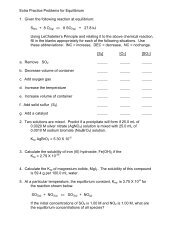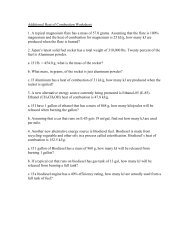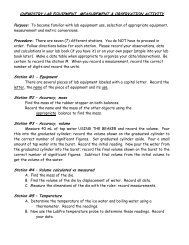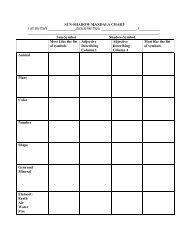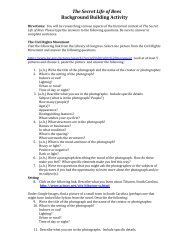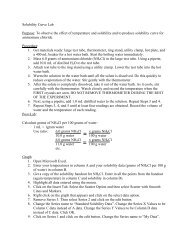Create successful ePaper yourself
Turn your PDF publications into a flip-book with our unique Google optimized e-Paper software.
Behavior of solid <strong>Zinc</strong> in an aqueous solution of <strong>Lead</strong> acetate<br />
Introduction:<br />
What mass <strong>and</strong> mole relationships are there in chemical reactions? Stoichiometry is the<br />
calculations that can be done with balanced chemical equations. Now that we have learned how<br />
to balance chemical equations, we will put our new knowledge to the test <strong>and</strong> calculate amounts<br />
of products <strong>and</strong> reactants based on our equation.<br />
In this experiment, you will find the mass of a sample of solid lead acetate<br />
(Pb(CH 3 COO) 2 3H 2 0) <strong>and</strong> prepare a water solution of it. You will also find the mass of a zinc<br />
strip, place it in solution, <strong>and</strong> observe its behavior. By finding the mass of the zinc strip at the<br />
close of the experiment, you will be able to investigate quantitatively any changes that occur.<br />
Procedure:<br />
Part I<br />
1. Obtain a strip of zinc. If it has been used before, clean it with steel wool or emery paper until a<br />
shiny surface is obtained.<br />
2. Mass your zinc strip. Take a weighing boat <strong>and</strong> zero out the scale.<br />
3. Mass 1.500 g of lead acetate into your weighing boat.<br />
4. Transfer the solid lead acetate to the 250-mL beaker. Add 200 mL of distilled water to the lead<br />
acetate <strong>and</strong> swirl gently until the entire solid dissolves. Add a few drops of concentrate acetic<br />
acid to clarify the solution.<br />
5. Place the zinc strip in the beaker <strong>and</strong> make sure zinc is completely covered.<br />
6. Observe for several minutes <strong>and</strong> record any changes that take place. Cover the beaker with<br />
parafilm <strong>and</strong> let sit overnight.<br />
Part II<br />
1. At the beginning of the next class observe the beaker <strong>and</strong> record any observations in your<br />
notebook.<br />
2. Remove the parafilm <strong>and</strong> remove the zinc from the solution (use tweezers if necessary). Use<br />
your wash bottle to wash all of the lead crystals off the zinc piece. Make sure to get all the lead<br />
off. Set the zinc aside on a paper towel to dry. When it is dry, find its mass.<br />
3. Let the lead settle in the beaker. Carefully decant the solution. Decant means to pour off<br />
liquid, leaving the solid behind. Wash the residue with 10 mL of water <strong>and</strong> carefully decant.<br />
Wash <strong>and</strong> decant at least three more times. Finally, wash the lead with 10 mL of acetone <strong>and</strong><br />
decant once again.<br />
4. After the final washing, the residue must be allowed to dry.<br />
5. Mass a clean piece of filter paper <strong>and</strong> filter the lead into the filter paper <strong>and</strong> glass funnel. Use<br />
the acetone wash bottle to make sure all the lead gets into the filter paper. Allow the filter paper<br />
to dry.<br />
6. Once the lead residue <strong>and</strong> paper are dry, mass the paper <strong>and</strong> lead to determine how much lead<br />
was produced.<br />
5. Dispose of the lead properly <strong>and</strong> clean the beaker. Wash your h<strong>and</strong>s <strong>and</strong> clean up your lab<br />
station.
Calculations<br />
1. Calculate the change in mass of the zinc strip.<br />
2. Calculate the mass of lead obtained.<br />
3. Calculate the number of moles of zinc reacted.<br />
4. Calculate the number of moles of lead produced.<br />
5. Determine the ratio of moles of Pb/ moles Zn.<br />
6. Calculate the moles of Pb(CH 3 COO) 2 3H 2 0 used in the experiment.<br />
7. Determine the ratio of moles of Pb/moles of Pb(CH 3 COO) 2 3H 2 0.<br />
8. How many individual atoms of zinc metal were involved in the experiment?<br />
9. How many individual atoms of lead metal were involved in the experiment?<br />
10. Calculate the theoretical yield of Pb from the amount of lead (II) acetate used.<br />
11. Calculate the percent yield.<br />
Conclusion<br />
Write the balanced chemical equation including states of matter for this experiment <strong>and</strong> then<br />
compare your coefficients to your answers for #5 <strong>and</strong> #7.




